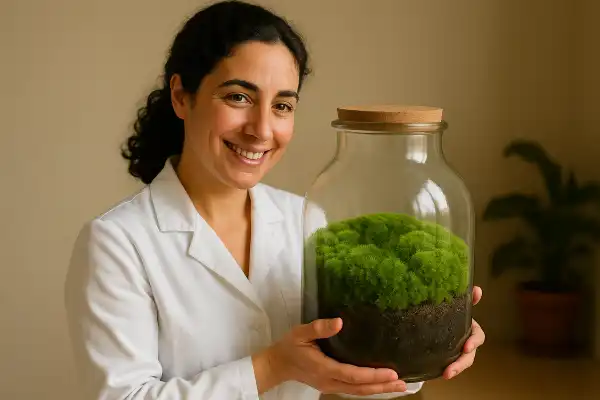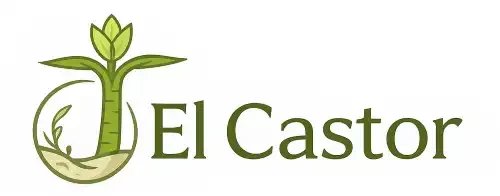Walking through any plant shop today, you’ll notice moss terrariums gaining popularity among both beginners and experienced plant enthusiasts. People often ask about moss terrariums because they represent the perfect marriage of low-maintenance care and stunning natural beauty—appealing to those who want to bring nature indoors without the complexity of traditional gardening. So, what is a moss terrarium?
Last month, I helped my neighbor create her first moss terrarium after she spotted the collection in my studio. Watching her face light up as we positioned each cushiony mound of moss reminded me why these miniature ecosystems hold such universal appeal.
Our question of June is: Is labradorite safe to use in damp terrariums?
What is a moss terrarium?
A moss terrarium, also commonly referred to as “mossaria,” is a clear enclosure used to grow specifically moss, creating a self-contained ecosystem that showcases these ancient, resilient plants. Mosses are small, flowerless plants belonging to the Bryophyta division that appeared on Earth approximately 450 million years ago, long before flowering plants appeared.

Understanding moss biology in terrarium environments
Unlike traditional plants, mosses are non-vascular plants that lack the conventional root, stem, and leaf system, instead absorbing water and nutrients mainly through their leaves. This unique characteristic makes them perfectly suited for terrarium life. Mosses have rhizoids which help them to attach to surfaces and absorb water and nutrients, functioning more like anchors than true roots.
The ectohydric nature of moss means they rely on external water sources to make direct contact for absorption. This adaptation allows moss terrariums to thrive in the high-humidity environment that glass containers naturally create through their water cycle.
Essential components of a moss terrarium
Building a proper moss terrarium requires understanding the layered foundation system. The key layers for a moss terrarium include a drainage layer usually consisting of gravel, rocks, and activated charcoal, which provides an easy way for stagnant water to escape and maintains stable humidity levels.
Drainage foundation The first step when making a mini moss terrarium is putting down a one inch layer of pebbles or gravel in the bottom of your container. On top of this put a layer of dried moss or sphagnum moss to separate the drainage from your growing medium.
Growing medium selection This layer of the mossarium is made up of some type of growing media, usually containing soil like coco coir or potting mix that should be kept moist at all times. You must aim for slightly acidic and well-draining soil to replicate the natural conditions where moss thrives.
Popular moss varieties for terrariums
Cushion moss, generally referring to the species Leucobryum glaucum, is most commonly found across North America and Europe, with green leaves distinctly formed to create a puffy pillow shape. This shape makes it an infinitely popular choice for use in terrariums to create the effect of hillsides and shrubbery.
Fern moss, found in Europe, Japan, and North America, enjoys a more neutral pH environment and typically grows up tree trunks, on rock surfaces, and along the forest floor. It’s a great choice of moss to create a miniature fern-forest aesthetic with its fluffy, delicate appearance.
Creating optimal growing conditions
Light requirements You must aim for indirect sunlight when positioning your moss terrarium. Moss doesn’t like direct sunlight, so make sure to choose a spot in your terrarium that gets filtered light. Direct sunlight will cause the moss to dry out and may damage the leaves.
Temperature management For most moss, the ideal temperature is between 60 and 70 degrees Fahrenheit or 15 to 21 degrees Celsius. If the temperature gets too hot, the moss will start to turn brown and will eventually die. Maintaining consistent temperatures helps moss establish and thrive in terrarium environments.
Moisture balance Moss terrarium care is extremely easy. Every now and again, spray your moss with a light mist. You don’t want to overwater it. If you can see condensation on the sides, then it’s already moist enough. It is important to water the moss slowly and evenly, as sudden or excessive watering can damage the delicate plant.
Water quality considerations
Moss prefers filtered or distilled water, as tap water can contain minerals that can build up and damage the moss over time. When watering moss, I would highly recommend using spray bottle or mister to water your moss, spraying the whole surface until it gets wet.
Maintenance and troubleshooting
Preventing common problems Mould usually develops due to poor air circulation, too much heat and too high a humidity. You should be careful not to keep the terrarium too wet as it can lead to mold, disease, and rotting roots. Regular monitoring during the first few weeks helps identify potential issues before they become serious problems.
Long-term care At least once a year, check over your terrarium and clear out dead leaves and remove anything that looks dead or particularly unwell. If you take proper care of your mosses, they will last for a year or even few in your terrarium.
Growth management If your moss completely takes off and grows exponentially, you may wish to simply let it do its thing, or you might want to keep it in check to maintain your special design using a long, thin pair of scissors to trim any unwanted excess.
Benefits beyond aesthetics
Moss helps to regulate moisture levels in the soil, preventing the roots of other plants from getting too wet or too dry when included in mixed terrariums. Mosses play essential roles in natural terrarium ecosystems by providing habitat and food for various microorganisms, insects, and small animals, while contributing to soil stabilization and nutrient cycling.
Conclusion
Three months ago, I created a moss terrarium using cushion moss collected during a weekend hike in the nearby mountains. The simple act of arranging those emerald pillows in a glass vessel transported me back to childhood days spent exploring forest floors. That terrarium now sits on my desk, a living reminder that some of nature’s most extraordinary beauty comes in the smallest packages. Through six years of terrarium building, moss has consistently proven itself as both forgiving for beginners and endlessly fascinating for experienced enthusiasts—exactly the kind of reliable partnership that makes indoor gardening truly rewarding.
El Castor is your exclusive terrarium guide.
